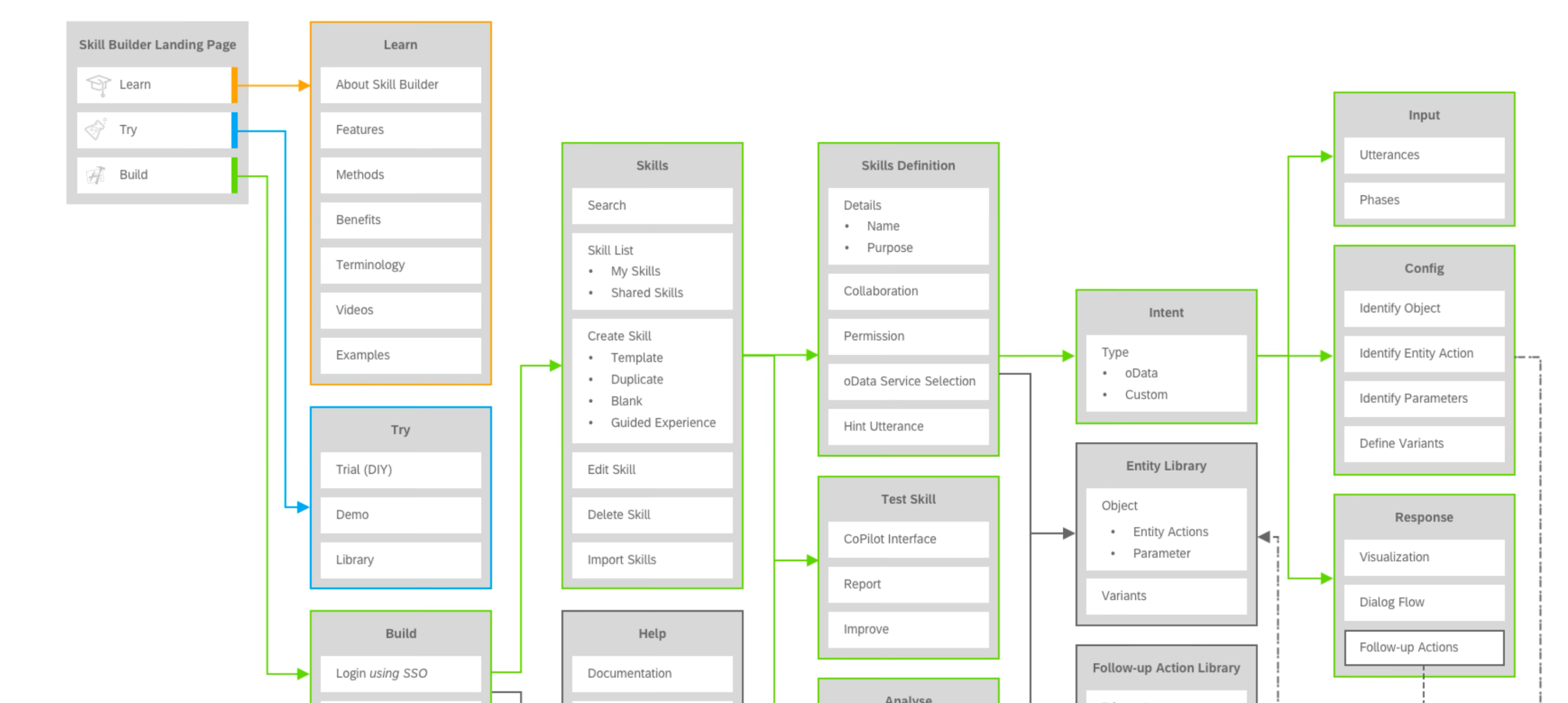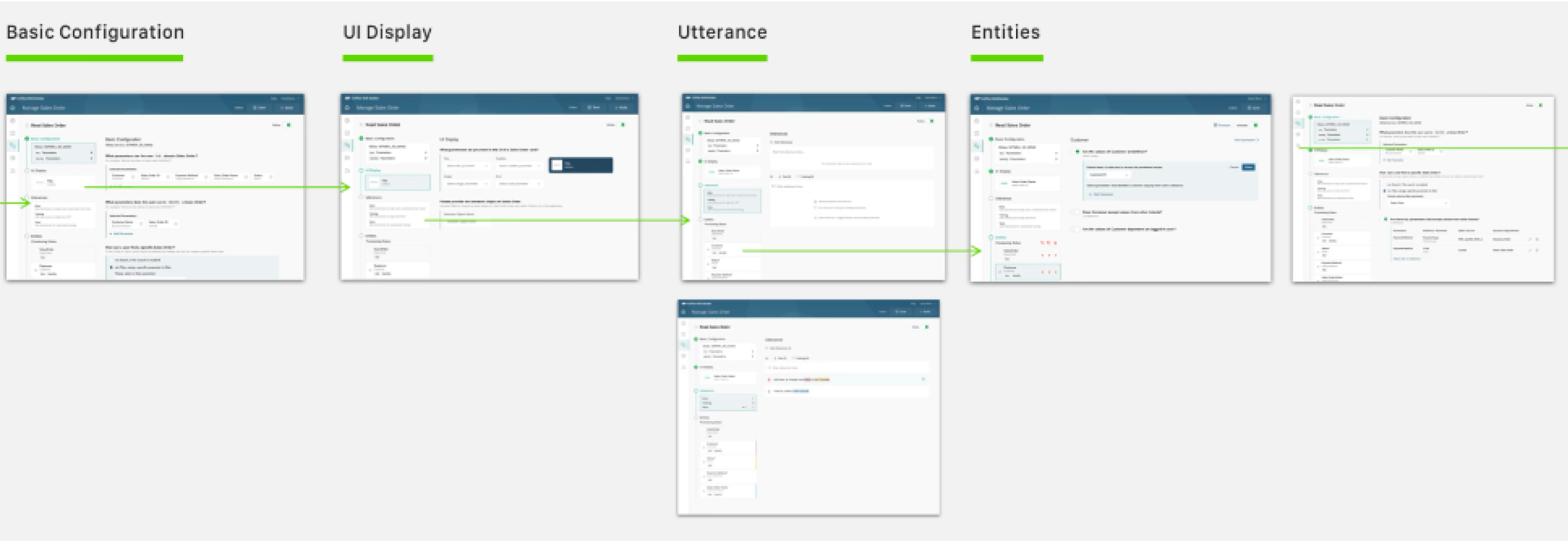SAP No-Code Skill Builder
Designed a scalable, no-code platform for building conversational AI experiences across SAP enterprise applications.
Project Overview
Timeline
2018–2019
Team Size
4 Designers, 1 UX Researcher, 1 Product Manager, 14 Developers
Role
UX Lead – Led UX strategy, delivery, and scope management
Summary
As user interfaces evolved from graphical to mobile and now to conversational UI, SAP sought to empower enterprises to keep pace. Leveraging AI and ML, SAP CoPilot emerged as a cloud-based digital assistant service to power conversational experiences across applications like S/4HANA, SuccessFactors, Hybris, Ariba, and Concur, and within communication tools like Slack, MS Teams, and GSuite.
The SAP No-Code Skill Builder was developed as a code-free platform to design and deploy conversational experiences at scale. Built for enterprise-readiness, it enabled users across different roles to create, configure, and test custom skills without writing a single line of code.

What is SAP CoPilot Skill Builder?
A no-code platform enabling conversational UX through reusable enterprise patterns:
- Code-free creation and management of skills and intents, allowing business users and designers to contribute without developer dependency
- Pattern-based design that leverages enterprise workflows like approvals, status tracking, and lookup services to build reusable skills
- Secure integration with backend systems such as S/4HANA, ensuring access control, role-based authorizations, and data consistency across applications

Key Personas & Their Tasks

Configurator / Admin
Configure skills for SAP CoPilot use

Project Manager
Define business goals, use cases, services, and utterances

UX Designer
Create dialogue flows, map task flows, and translate user needs into conversation logic

Developer
Evaluate technical feasibility, test and publish skills

Linguist
Define linguistic rules, synonyms, dictionaries, and train NLP models
Our UX Approach
Set Expectations
Conducted stakeholder alignment meetings to establish design goals, timeline, deliverables, and ownership across teams

Conduct Workshops
Ran cross-functional workshops to understand technical constraints, map existing workflows, and identify key user needs across personas

Create a Hero Story
Crafted a central narrative and user scenario that illustrated how the Skill Builder would solve real user problems end-to-end

Idea Generation
Used collaborative idea cards to explore conversational UI use cases and map features back to user goals

Define User Journey
Created journey maps to illustrate the end-to-end experience of each persona including triggers, tasks, tools, and pain points

Information Architecture
Structured the platform into logical modules and flows for scalable use, informed by user interviews and system capabilities

Lo-Fi Validation
Designed quick, testable wireframes to validate dialog flow, task breakdown, and usability with stakeholders and potential users

Design for Development
Delivered high-fidelity mockups with component specs, interaction guidelines, and developer annotations to ensure implementation accuracy

Key Screens & Experience Highlights

Product Query Configuration - Defining parameters and entities for conversational interactions

Intent Creation - Building conversational skills by connecting to backend business objects and services
Outcomes & Impact
The engagement and collaboration between distributed teams were highly appreciated by stakeholders for their seamless execution. The success and usability of the Skill Builder platform led to a noticeable upward trend in the adoption of SAP CoPilot, enabling business users to independently build custom assistants tailored to their enterprise needs.
By the end of Q4 2018:
Skills created using SAP CoPilot Skill Builder
Daily active users engaged with the tool
Unique tenants, primarily across S/4HANA and SuccessFactors modules
User engagement from skill-based interactions, indicating high adoption
This accessibility opened the door for countless use cases across the SAP ecosystem and helped democratize the use of conversational interfaces. The project gained visibility beyond its immediate teams and was featured as one of the main attractions during the SAP SAPPHIRE event in 2018.
Challenges & Constraints
Distributed Team Coordination
The project team was distributed across multiple time zones and locations, requiring precise coordination to make the most of limited overlapping work hours. This added a layer of complexity to workshops, design reviews, and daily collaboration.
Technical Complexity vs. Usability
Designing for non-technical users in a highly technical enterprise environment posed a significant challenge. We had to strike the right balance between offering powerful, flexible functionality while maintaining an intuitive, approachable user experience.
Enterprise Security Compliance
All features and workflows had to comply with SAP's strict security standards and integrate seamlessly with backend enterprise systems, adding complexity to the design process.
Conversational UI Paradigm
Creating a no-code platform for conversational experiences required rethinking traditional UI patterns and developing new mental models for users unfamiliar with conversation design.
Reflections & Learnings
Distributed Teams as Strength
It was amazing to see the entire team come together across geographies. In fact, the distributed nature of the team turned into a strength — allowing us to make overnight progress through staggered work cycles and accelerate idea exploration and feasibility checks.
Research-Driven Conversations
One of the most important aspects of designing for conversational AI was research and continuous user testing. Since these experiences lacked a visual UI, we had to rely deeply on understanding user mental models, their working environments, and typical tasks to ensure the right intents and flows.
Validation Through Usage
The success of this project confirmed that enabling non-technical users to create meaningful conversational experiences was not only possible but scalable. By prioritizing outcome-focused flows and reducing technical barriers, we observed a sharp rise in skill-based interactions (87% of usage), a clear validation of our design direction.
Guided Flexibility
We learned that thoughtful, guided workflows paired with enterprise-grade flexibility can unlock innovation—even for complex domains like conversational UI in business systems.